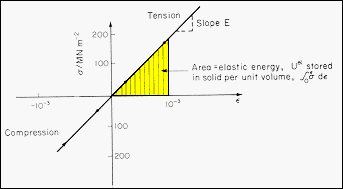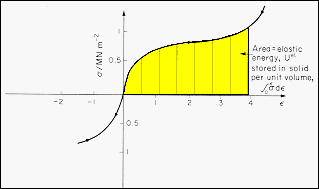| The
diagrams opposite show stress-strain curves for a linear elastic material
such as a metal (top) and a non-linear elastic material such as rubber
(bottom). If these materials are taken to some strain condition work has
to be done against the elastic stress and this is represented by the area
under the curve shown in yellow on the diagrams. This area is the elastic
energy per unit volume stored in the material at this strain.
For
the linear material, the slope of the curve is constant and equal to Young's
modulus. From Hooke's law:
s
= Ee,
so that the area under the curve is: U*
= (se/2)
= (Ee2/2)
= (s2/2E).
For this material the unloading curve overlays the loading curve.
For
the non-linear material the energy per unit volume must be computed by
summing (integrating) elements (sde)
to give the area under the curve: U* = Sesde.
When unloading, the curve may not overlay the loading curve and a net amount
of work may be done in a cycle. This work will heat the material. |

